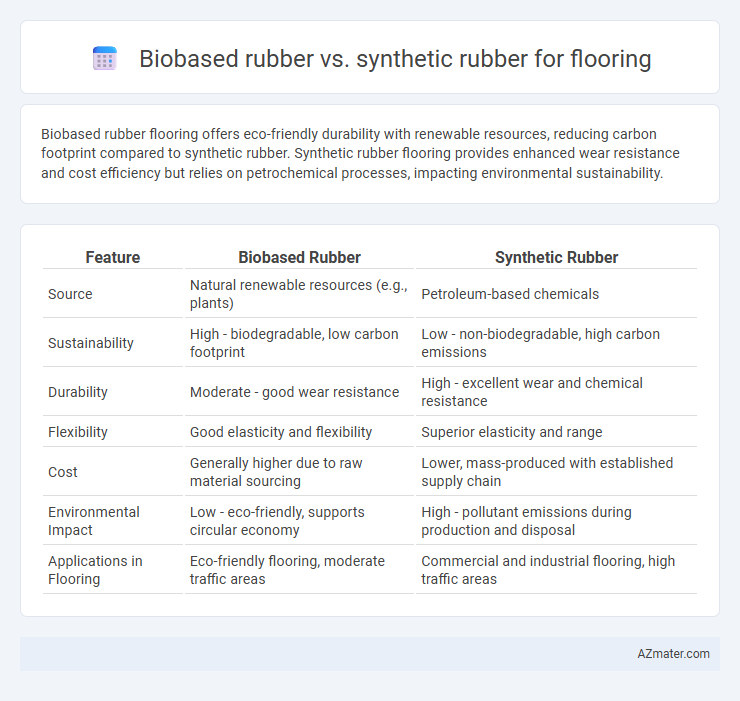Biobased rubber flooring offers eco-friendly durability with renewable resources, reducing carbon footprint compared to synthetic rubber. Synthetic rubber flooring provides enhanced wear resistance and cost efficiency but relies on petrochemical processes, impacting environmental sustainability.
Table of Comparison
| Feature | Biobased Rubber | Synthetic Rubber |
|---|---|---|
| Source | Natural renewable resources (e.g., plants) | Petroleum-based chemicals |
| Sustainability | High - biodegradable, low carbon footprint | Low - non-biodegradable, high carbon emissions |
| Durability | Moderate - good wear resistance | High - excellent wear and chemical resistance |
| Flexibility | Good elasticity and flexibility | Superior elasticity and range |
| Cost | Generally higher due to raw material sourcing | Lower, mass-produced with established supply chain |
| Environmental Impact | Low - eco-friendly, supports circular economy | High - pollutant emissions during production and disposal |
| Applications in Flooring | Eco-friendly flooring, moderate traffic areas | Commercial and industrial flooring, high traffic areas |
Introduction to Biobased and Synthetic Rubber Flooring
Biobased rubber flooring is derived from renewable natural sources such as natural latex harvested from rubber trees, offering an eco-friendly alternative with biodegradable properties and reduced carbon footprint. Synthetic rubber flooring, typically made from petrochemical-based materials like styrene-butadiene rubber (SBR) or ethylene propylene diene monomer (EPDM), provides enhanced durability, resistance to wear and chemical exposure, and a wider range of design options. Both materials serve different performance needs in flooring applications, with biobased rubber emphasizing sustainability and synthetic rubber focusing on long-term resilience and versatility.
Material Composition and Sources
Biobased rubber for flooring primarily consists of natural polymers derived from renewable sources such as Hevea brasiliensis latex and guayule plants, offering eco-friendly alternatives with lower carbon footprints. Synthetic rubber, typically composed of petrochemical-derived polymers like styrene-butadiene rubber (SBR) and nitrile rubber (NBR), provides consistent material properties and enhanced durability. The material composition of biobased rubber emphasizes biodegradability and sustainability, while synthetic rubber focuses on uniformity and resistance to wear and chemicals.
Environmental Impact and Sustainability
Biobased rubber flooring significantly reduces environmental impact by utilizing renewable resources and lowering carbon emissions compared to petroleum-based synthetic rubber. The biodegradability and recyclability of biobased rubber contribute to sustainable waste management, minimizing landfill accumulation and environmental pollution. In contrast, synthetic rubber relies on fossil fuels, producing higher greenhouse gas emissions and posing challenges in recycling, resulting in a larger ecological footprint.
Performance and Durability Comparison
Biobased rubber offers enhanced eco-friendliness and comparable elasticity to synthetic rubber, making it a sustainable option for flooring applications. Synthetic rubber typically provides superior abrasion resistance and long-term durability under heavy foot traffic and harsh environmental conditions. Both materials exhibit excellent resilience, but synthetic rubber generally outperforms in longevity and resistance to chemicals, while biobased rubber emphasizes renewable sourcing and biodegradability.
Health and Safety Considerations
Biobased rubber flooring offers reduced exposure to volatile organic compounds (VOCs) and fewer harmful chemical additives compared to synthetic rubber, promoting better indoor air quality and minimizing health risks for occupants. Its natural origin often results in hypoallergenic properties and lower emissions of toxic substances, making it a safer choice for environments like schools and healthcare facilities. In contrast, synthetic rubber flooring may contain petroleum-based compounds and plasticizers that pose potential long-term health hazards and require careful management during installation and disposal.
Cost Analysis and Economic Viability
Biobased rubber flooring typically incurs higher initial costs due to raw material sourcing and lower production scale compared to synthetic rubber, which benefits from established manufacturing infrastructure and economies of scale. However, the economic viability of biobased rubber improves over time through government incentives, reduced environmental compliance costs, and potential market premiums for sustainable products. Synthetic rubber remains cost-effective for large-scale projects, but biobased alternatives are gaining competitiveness as advancements in biofabrication reduce costs and enhance performance consistency.
Installation and Maintenance Requirements
Biobased rubber flooring typically requires less intensive installation processes due to its natural flexibility and compatibility with eco-friendly adhesives, reducing overall labor and material costs. Maintenance of biobased rubber involves simpler cleaning routines using non-toxic, biodegradable agents, enhancing indoor air quality and sustainability. Synthetic rubber flooring often demands more specialized installation techniques and chemical-resistant adhesives, while its upkeep may require stronger cleaners to manage wear and maintain appearance over time.
Applications in Residential and Commercial Flooring
Biobased rubber flooring offers sustainable benefits with natural elasticity and excellent slip resistance, making it ideal for eco-conscious residential spaces and high-traffic commercial areas requiring durability. Synthetic rubber flooring provides superior abrasion resistance and chemical stability, preferred in commercial settings such as gyms, hospitals, and industrial facilities due to heavy wear and frequent cleaning needs. Both materials support versatility in design and cushioning, but biobased rubber excels in environments prioritizing environmental impact and indoor air quality.
Market Trends and Consumer Preferences
The flooring market shows a significant shift towards biobased rubber due to increasing consumer demand for sustainable and eco-friendly materials, driven by environmental regulations and green building certifications. Synthetic rubber remains favored for its durability and cost-effectiveness but faces growing scrutiny over its environmental impact. Market analysis indicates that the biobased rubber segment is projected to grow at a CAGR of over 8% in the next five years, reflecting rising adoption in residential and commercial flooring applications.
Future Prospects for Rubber Flooring Technologies
Biobased rubber flooring leverages renewable resources such as natural latex and plant-derived polymers, offering enhanced sustainability and reduced carbon footprint compared to synthetic rubber made from petrochemicals. Advancements in bioengineering and material science are driving innovations in durability, elasticity, and resistance to wear, positioning biobased rubber as a viable alternative for eco-friendly flooring solutions. Future prospects emphasize hybrid composites combining biobased and synthetic elements to optimize performance while meeting stringent environmental standards in commercial and residential flooring applications.

Infographic: Biobased rubber vs Synthetic rubber for Flooring
 azmater.com
azmater.com